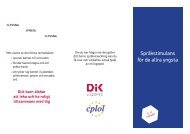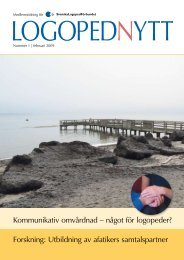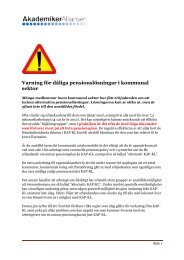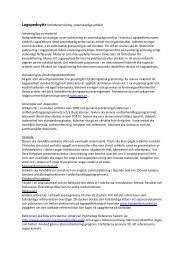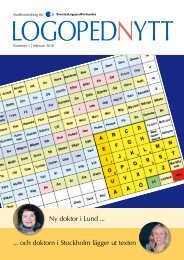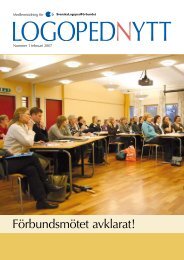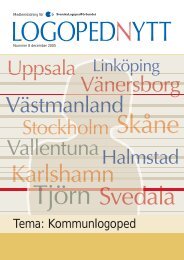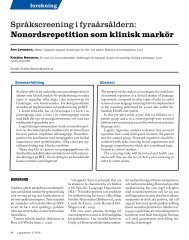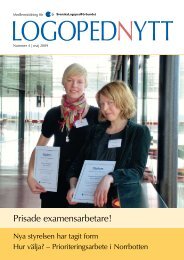Logopedi i andra länder CPLOL:s svenska ordförande tackar ... - DIK
Logopedi i andra länder CPLOL:s svenska ordförande tackar ... - DIK
Logopedi i andra länder CPLOL:s svenska ordförande tackar ... - DIK
Create successful ePaper yourself
Turn your PDF publications into a flip-book with our unique Google optimized e-Paper software.
t e M A L O g O P e d I V Ä R L d e N R U N t<br />
I Logopednytt rapporteras det ofta om vad logopeder jobbar med runt om i landet<br />
(du har väl inte missat vår nya följetong Hur är det hos ...?). Men vad jobbar<br />
logopeder i <strong>andra</strong> <strong>länder</strong> med? Vad finns det för likheter och skillnader jämfört med<br />
vår situation i Sverige? Redaktionen kontaktade några kollegor utomlands och fick<br />
följande rapporter från Sydafrika, Belgien, USA och Island.<br />
Shared reading intervention in South Africa<br />
Dialogic reading: Shared picture<br />
book reading for preschool children<br />
South African children from disadvantaged<br />
communities often start their formal education<br />
without the language and literate<br />
skills needed to succeed academically.<br />
They often come from environments that<br />
don’t provide them with experiences with<br />
books, reading and literacy practices.<br />
Speechlanguage therapists and educators<br />
working in disadvantaged communities<br />
often use shared storybook reading in<br />
intervention programs to introduce preschool<br />
children to books and to foster<br />
more complex language skills. Repeated<br />
exposure to reading and storybooks from<br />
an early age can be an effective way to<br />
facilitate the development of literate<br />
language skills and the complex language<br />
structures that occur in written language,<br />
but not in oral language. Exposure to storybooks<br />
provides children with emergent<br />
literacy skills such as print awareness,<br />
enjoying a picture book.<br />
phonological awareness and alphabetic<br />
skills in the context in which they will later<br />
be required to apply these skills. Book<br />
sharing that explicitly encourages preschool<br />
children to engage in making<br />
inferences could foster skills that they will<br />
later use in text comprehension during<br />
independent reading.<br />
Dialogic reading is an example of a<br />
shared reading intervention aimed at the<br />
facilitation of an interactive dialogue<br />
between the adult and child during storybook<br />
reading. During dialogic reading the<br />
child becomes an active participant in the<br />
shared reading process and becomes the<br />
storyteller. The role of the adult is to<br />
expand the child’s utterances through<br />
openended questions and prompts.<br />
Teachers, parents and caregivers can be<br />
trained to do dialogic reading in classrooms<br />
and at home. Studies have showed<br />
that even relatively brief interventions<br />
using dialogic reading enhance expressive<br />
and emergent literacy skills in young<br />
children from lower socioeconomic<br />
groups.<br />
Dialogic reading:<br />
During repeated reading of a storybook<br />
the adult encourages the child to become<br />
the teller of the story over time through<br />
prompts and questions. The acronyms<br />
CROWD and PEER refer to the techniques<br />
used by adults during dialogic<br />
reading to guide and facilitate the interaction.<br />
CROWD refers to:<br />
Completion prompts (e.g. the cat caught<br />
a …),<br />
Recall prompts (e.g. can you remember<br />
what the girl said to the boy?),<br />
Openended prompts (e.g. what can you<br />
tell me about this page?),<br />
WHprompts (e.g. what, where, who,<br />
why questions),<br />
Distancing prompts (questions and<br />
Shared reading by daleen Klop and preschool children.<br />
prompts that require children to relate<br />
the content of the book to their own<br />
experiences, e.g. tell me about a time<br />
when you were also scared)<br />
PEER refers to:<br />
Prompt the child to name objects in the<br />
book (e.g. what do you see in this picture?)<br />
Evaluate the child’s response (e.g. yes,<br />
that’s right, it is a cat)<br />
Expand the child’s response (e.g. the cat<br />
was Peter’s pet)<br />
Repeat and reinforce the expansion<br />
(e.g. Peter loved his pet cat)<br />
Daleen Klop, Department of Speech-Language<br />
and Hearing Therapy, Stellenbosch University<br />
South Africa, dk@sun.ac.za<br />
ReFeReNCeS<br />
Lonigan, C. J. & Whitehurst g.J. 1998. Relative<br />
efficacy of parent and teacher involvement in<br />
a shared-reading intervention for preschool<br />
children from low-income backgrounds. Early<br />
Childhood Research Quarterly 13, 263-290.<br />
Whitehurst, g. e., Arnold, d. S., epstein, J. N.,<br />
Angell, A. L., Smith, M. & Fischel, J. 1994. A<br />
picture book reading intervention in daycare<br />
and home for children from low-income families.<br />
Developmental Psychology 30: 679-689.<br />
6 LOgOPedNytt 2/10



